Research Proposal: Design and Optimization of Electric Braking System
VerifiedAdded on 2023/06/11
|18
|4666
|168
Report
AI Summary
This research proposal investigates the design and optimization of electric regenerative braking systems to enhance electric vehicle performance by utilizing regenerative braking energy. It reviews existing literature, focusing on methods to improve energy recapture and efficiency, including the use of CVT models and PSO techniques. The proposal outlines a research methodology incorporating computer simulations, mathematical models, and secondary sources to analyze the impact of regenerative braking on vehicle performance. It emphasizes the importance of considering factors like road friction and mechanical loss. The literature review covers various studies on regenerative braking strategies, energy flow optimization, and hydraulic regenerative braking systems, highlighting the potential for fuel consumption reduction and energy efficiency improvement in electric and hybrid vehicles. The project aims to define efficient regenerative braking strategies and contribute to the development of acceptable torque ranges for optimal energy recapture.
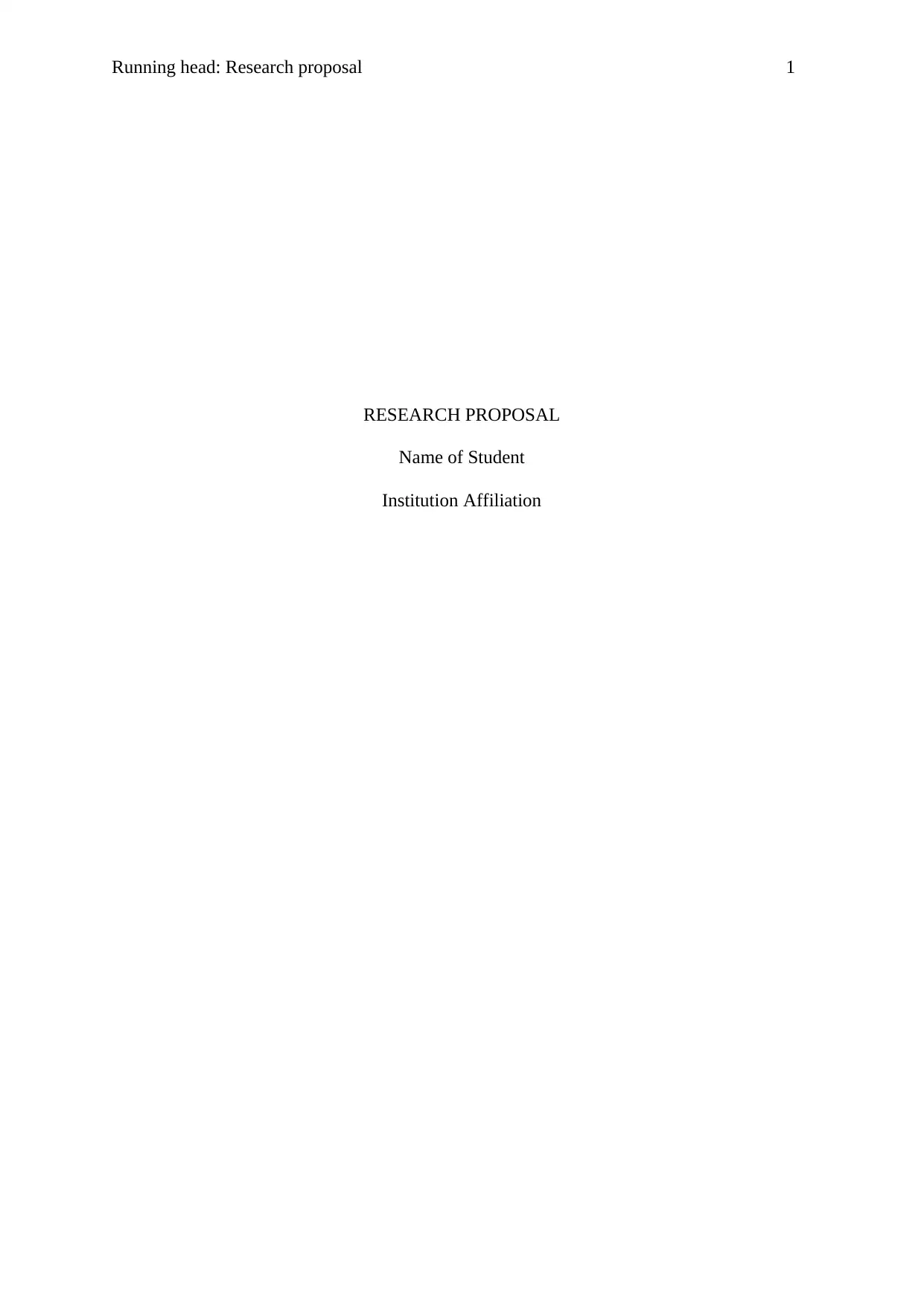
Running head: Research proposal 1
RESEARCH PROPOSAL
Name of Student
Institution Affiliation
RESEARCH PROPOSAL
Name of Student
Institution Affiliation
Paraphrase This Document
Need a fresh take? Get an instant paraphrase of this document with our AI Paraphraser
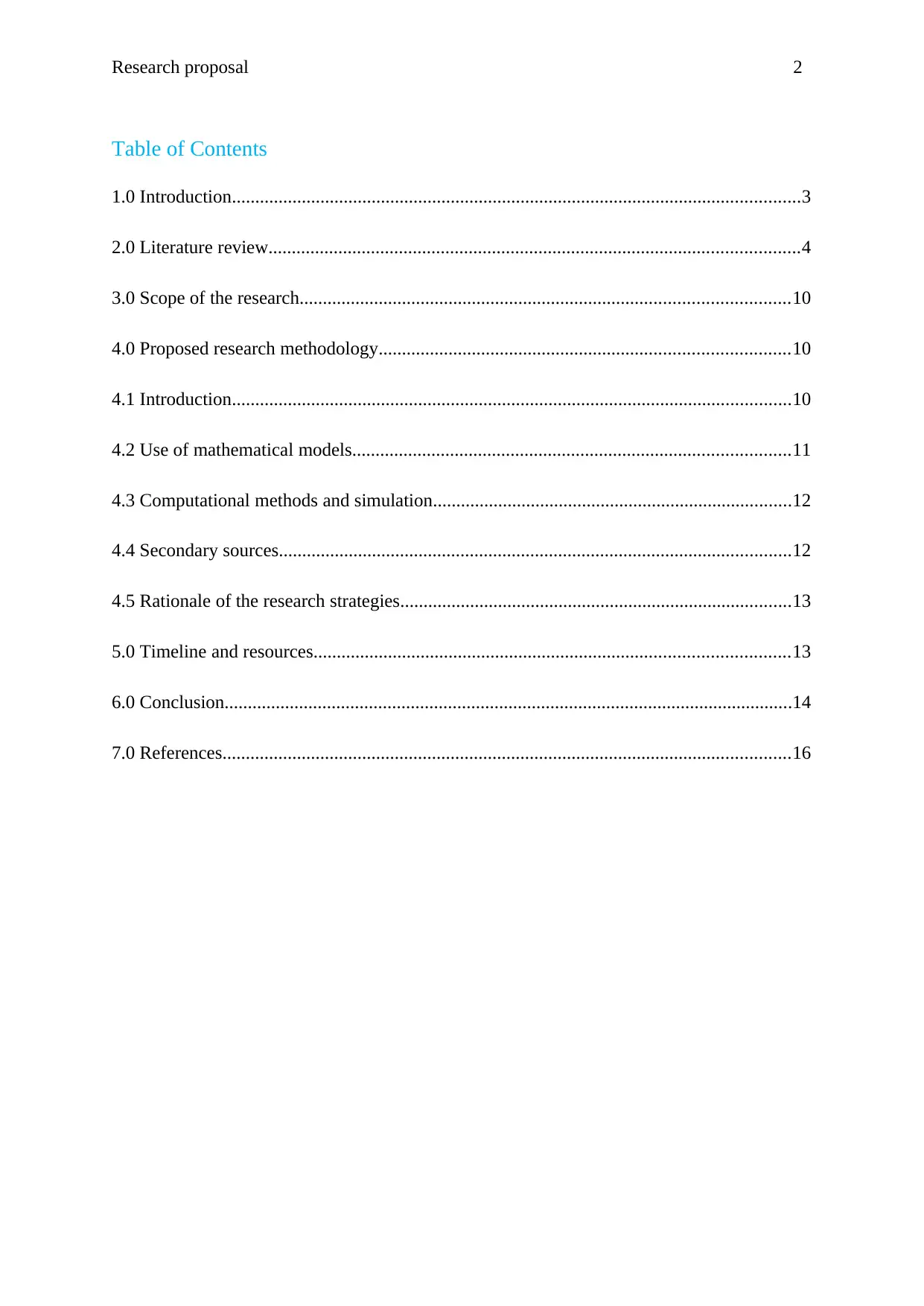
Research proposal 2
Table of Contents
1.0 Introduction..........................................................................................................................3
2.0 Literature review..................................................................................................................4
3.0 Scope of the research.........................................................................................................10
4.0 Proposed research methodology........................................................................................10
4.1 Introduction........................................................................................................................10
4.2 Use of mathematical models..............................................................................................11
4.3 Computational methods and simulation.............................................................................12
4.4 Secondary sources..............................................................................................................12
4.5 Rationale of the research strategies....................................................................................13
5.0 Timeline and resources......................................................................................................13
6.0 Conclusion..........................................................................................................................14
7.0 References..........................................................................................................................16
Table of Contents
1.0 Introduction..........................................................................................................................3
2.0 Literature review..................................................................................................................4
3.0 Scope of the research.........................................................................................................10
4.0 Proposed research methodology........................................................................................10
4.1 Introduction........................................................................................................................10
4.2 Use of mathematical models..............................................................................................11
4.3 Computational methods and simulation.............................................................................12
4.4 Secondary sources..............................................................................................................12
4.5 Rationale of the research strategies....................................................................................13
5.0 Timeline and resources......................................................................................................13
6.0 Conclusion..........................................................................................................................14
7.0 References..........................................................................................................................16
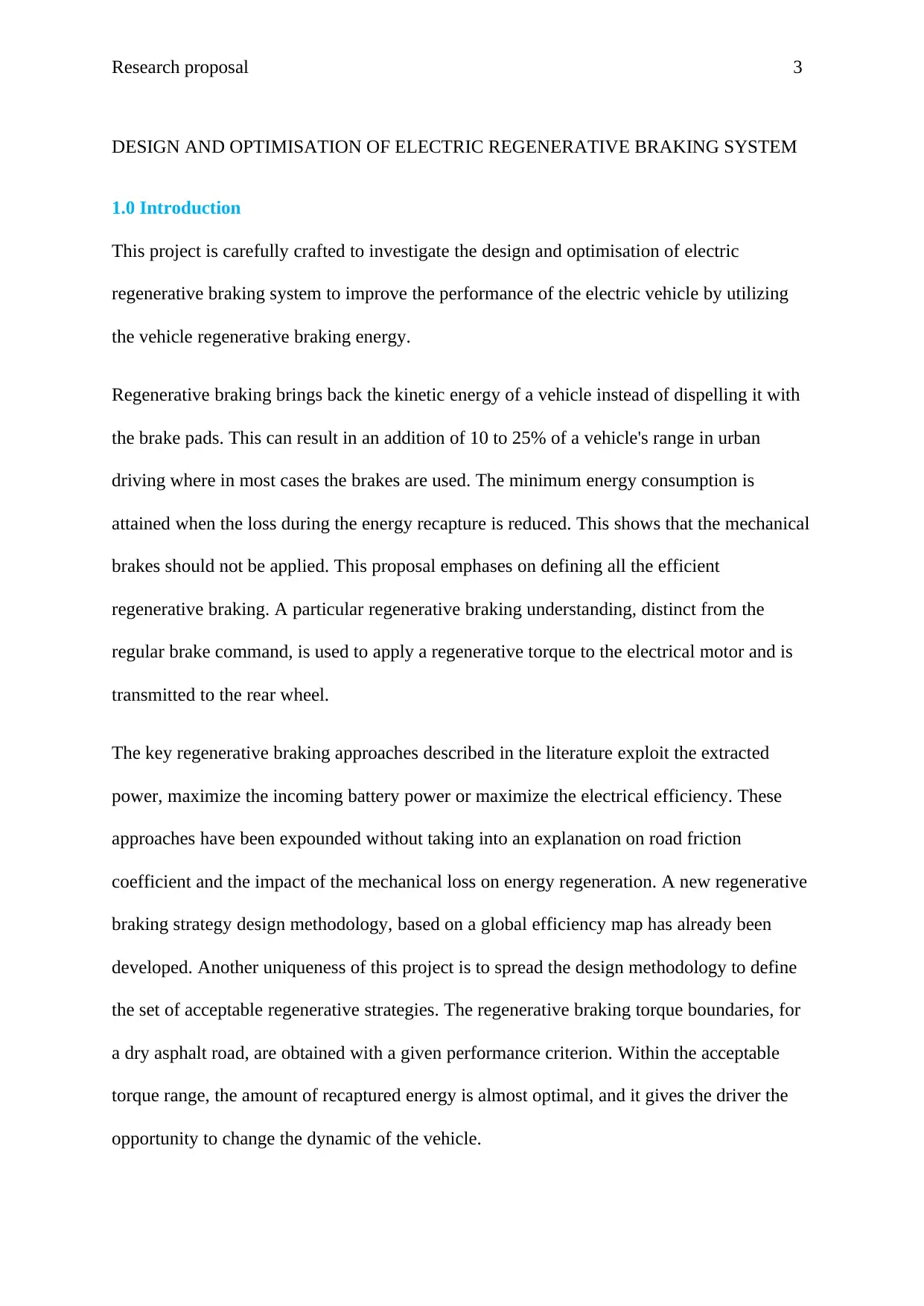
Research proposal 3
DESIGN AND OPTIMISATION OF ELECTRIC REGENERATIVE BRAKING SYSTEM
1.0 Introduction
This project is carefully crafted to investigate the design and optimisation of electric
regenerative braking system to improve the performance of the electric vehicle by utilizing
the vehicle regenerative braking energy.
Regenerative braking brings back the kinetic energy of a vehicle instead of dispelling it with
the brake pads. This can result in an addition of 10 to 25% of a vehicle's range in urban
driving where in most cases the brakes are used. The minimum energy consumption is
attained when the loss during the energy recapture is reduced. This shows that the mechanical
brakes should not be applied. This proposal emphases on defining all the efficient
regenerative braking. A particular regenerative braking understanding, distinct from the
regular brake command, is used to apply a regenerative torque to the electrical motor and is
transmitted to the rear wheel.
The key regenerative braking approaches described in the literature exploit the extracted
power, maximize the incoming battery power or maximize the electrical efficiency. These
approaches have been expounded without taking into an explanation on road friction
coefficient and the impact of the mechanical loss on energy regeneration. A new regenerative
braking strategy design methodology, based on a global efficiency map has already been
developed. Another uniqueness of this project is to spread the design methodology to define
the set of acceptable regenerative strategies. The regenerative braking torque boundaries, for
a dry asphalt road, are obtained with a given performance criterion. Within the acceptable
torque range, the amount of recaptured energy is almost optimal, and it gives the driver the
opportunity to change the dynamic of the vehicle.
DESIGN AND OPTIMISATION OF ELECTRIC REGENERATIVE BRAKING SYSTEM
1.0 Introduction
This project is carefully crafted to investigate the design and optimisation of electric
regenerative braking system to improve the performance of the electric vehicle by utilizing
the vehicle regenerative braking energy.
Regenerative braking brings back the kinetic energy of a vehicle instead of dispelling it with
the brake pads. This can result in an addition of 10 to 25% of a vehicle's range in urban
driving where in most cases the brakes are used. The minimum energy consumption is
attained when the loss during the energy recapture is reduced. This shows that the mechanical
brakes should not be applied. This proposal emphases on defining all the efficient
regenerative braking. A particular regenerative braking understanding, distinct from the
regular brake command, is used to apply a regenerative torque to the electrical motor and is
transmitted to the rear wheel.
The key regenerative braking approaches described in the literature exploit the extracted
power, maximize the incoming battery power or maximize the electrical efficiency. These
approaches have been expounded without taking into an explanation on road friction
coefficient and the impact of the mechanical loss on energy regeneration. A new regenerative
braking strategy design methodology, based on a global efficiency map has already been
developed. Another uniqueness of this project is to spread the design methodology to define
the set of acceptable regenerative strategies. The regenerative braking torque boundaries, for
a dry asphalt road, are obtained with a given performance criterion. Within the acceptable
torque range, the amount of recaptured energy is almost optimal, and it gives the driver the
opportunity to change the dynamic of the vehicle.
⊘ This is a preview!⊘
Do you want full access?
Subscribe today to unlock all pages.

Trusted by 1+ million students worldwide
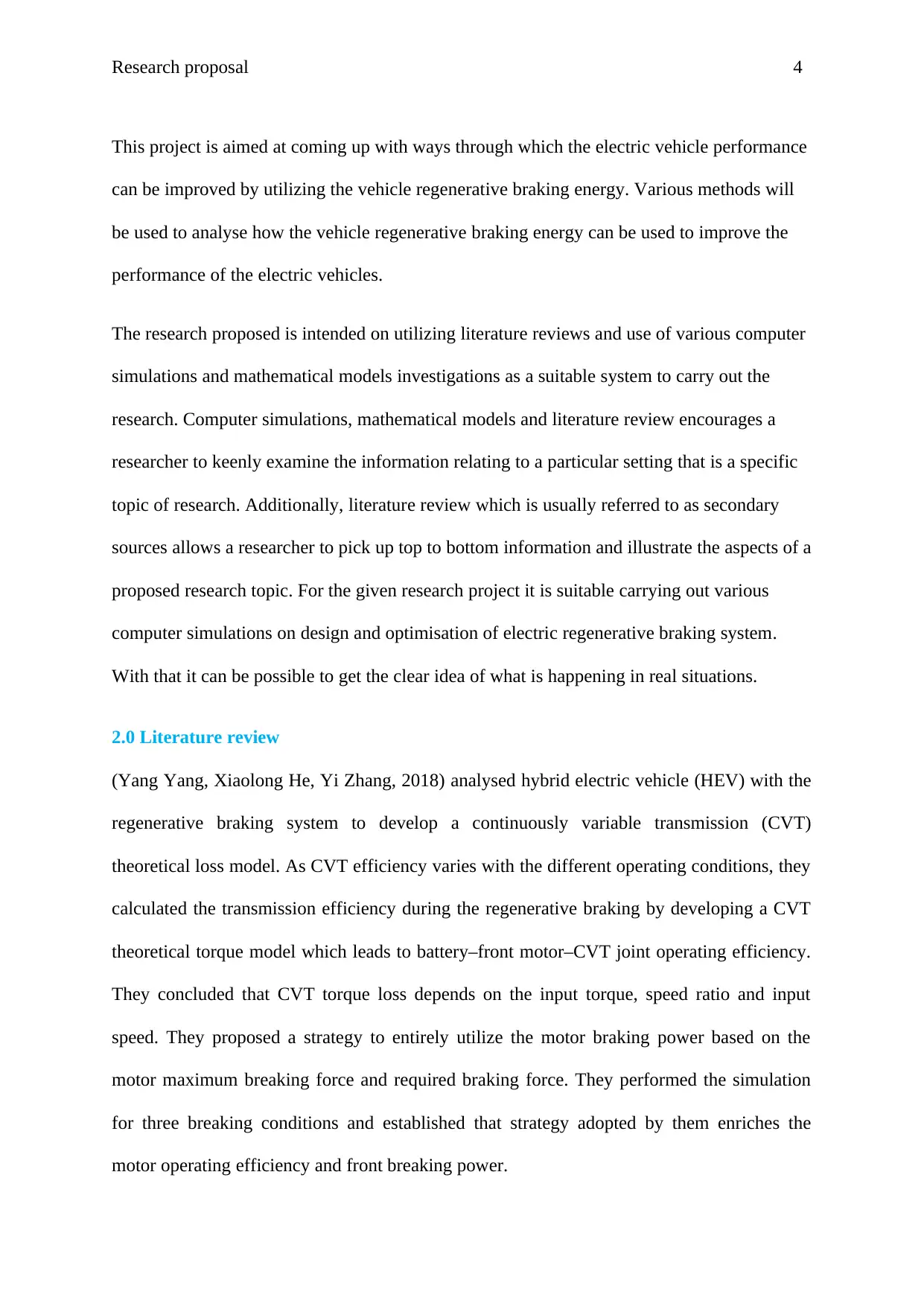
Research proposal 4
This project is aimed at coming up with ways through which the electric vehicle performance
can be improved by utilizing the vehicle regenerative braking energy. Various methods will
be used to analyse how the vehicle regenerative braking energy can be used to improve the
performance of the electric vehicles.
The research proposed is intended on utilizing literature reviews and use of various computer
simulations and mathematical models investigations as a suitable system to carry out the
research. Computer simulations, mathematical models and literature review encourages a
researcher to keenly examine the information relating to a particular setting that is a specific
topic of research. Additionally, literature review which is usually referred to as secondary
sources allows a researcher to pick up top to bottom information and illustrate the aspects of a
proposed research topic. For the given research project it is suitable carrying out various
computer simulations on design and optimisation of electric regenerative braking system.
With that it can be possible to get the clear idea of what is happening in real situations.
2.0 Literature review
(Yang Yang, Xiaolong He, Yi Zhang, 2018) analysed hybrid electric vehicle (HEV) with the
regenerative braking system to develop a continuously variable transmission (CVT)
theoretical loss model. As CVT efficiency varies with the different operating conditions, they
calculated the transmission efficiency during the regenerative braking by developing a CVT
theoretical torque model which leads to battery–front motor–CVT joint operating efficiency.
They concluded that CVT torque loss depends on the input torque, speed ratio and input
speed. They proposed a strategy to entirely utilize the motor braking power based on the
motor maximum breaking force and required braking force. They performed the simulation
for three breaking conditions and established that strategy adopted by them enriches the
motor operating efficiency and front breaking power.
This project is aimed at coming up with ways through which the electric vehicle performance
can be improved by utilizing the vehicle regenerative braking energy. Various methods will
be used to analyse how the vehicle regenerative braking energy can be used to improve the
performance of the electric vehicles.
The research proposed is intended on utilizing literature reviews and use of various computer
simulations and mathematical models investigations as a suitable system to carry out the
research. Computer simulations, mathematical models and literature review encourages a
researcher to keenly examine the information relating to a particular setting that is a specific
topic of research. Additionally, literature review which is usually referred to as secondary
sources allows a researcher to pick up top to bottom information and illustrate the aspects of a
proposed research topic. For the given research project it is suitable carrying out various
computer simulations on design and optimisation of electric regenerative braking system.
With that it can be possible to get the clear idea of what is happening in real situations.
2.0 Literature review
(Yang Yang, Xiaolong He, Yi Zhang, 2018) analysed hybrid electric vehicle (HEV) with the
regenerative braking system to develop a continuously variable transmission (CVT)
theoretical loss model. As CVT efficiency varies with the different operating conditions, they
calculated the transmission efficiency during the regenerative braking by developing a CVT
theoretical torque model which leads to battery–front motor–CVT joint operating efficiency.
They concluded that CVT torque loss depends on the input torque, speed ratio and input
speed. They proposed a strategy to entirely utilize the motor braking power based on the
motor maximum breaking force and required braking force. They performed the simulation
for three breaking conditions and established that strategy adopted by them enriches the
motor operating efficiency and front breaking power.
Paraphrase This Document
Need a fresh take? Get an instant paraphrase of this document with our AI Paraphraser
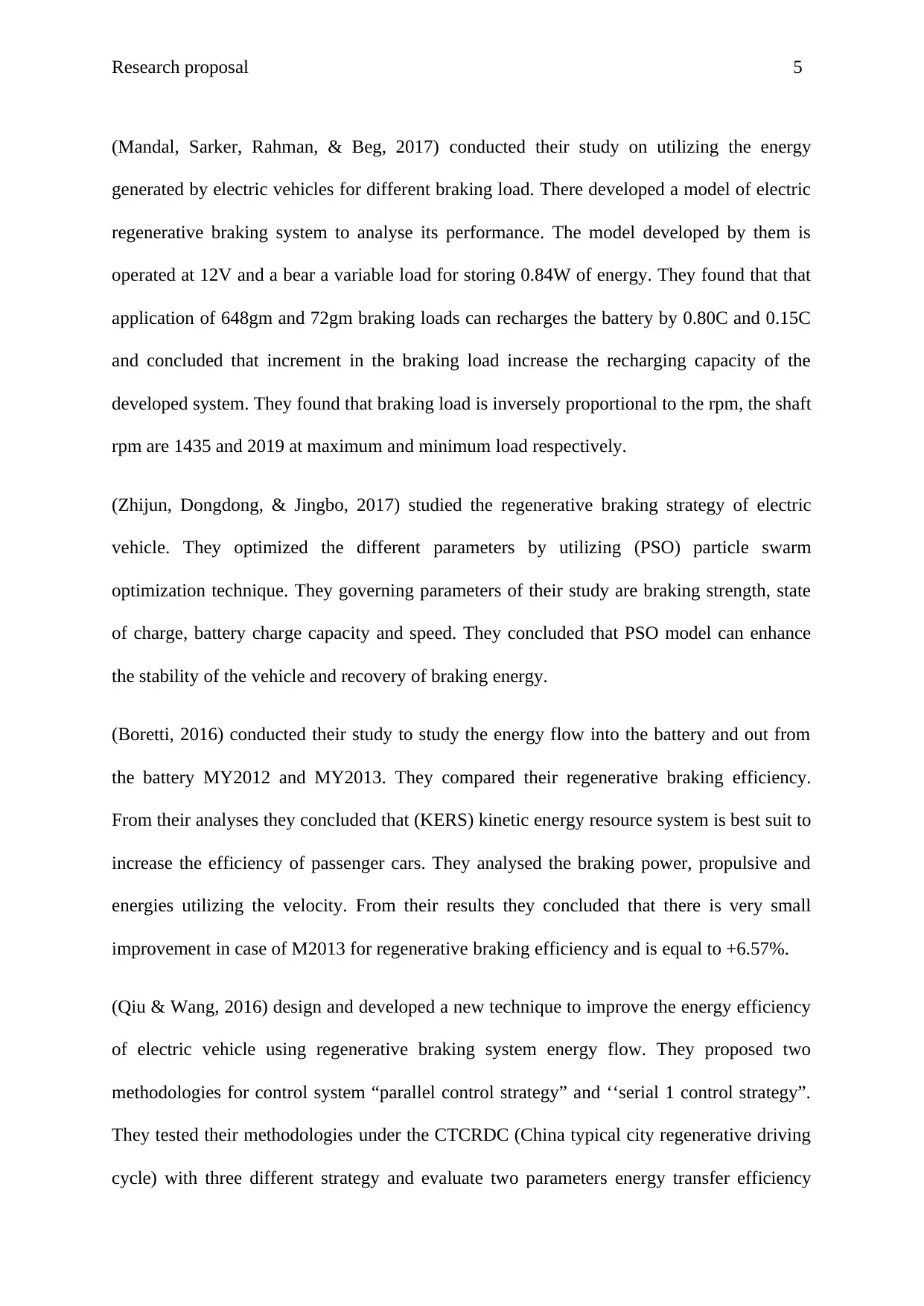
Research proposal 5
(Mandal, Sarker, Rahman, & Beg, 2017) conducted their study on utilizing the energy
generated by electric vehicles for different braking load. There developed a model of electric
regenerative braking system to analyse its performance. The model developed by them is
operated at 12V and a bear a variable load for storing 0.84W of energy. They found that that
application of 648gm and 72gm braking loads can recharges the battery by 0.80C and 0.15C
and concluded that increment in the braking load increase the recharging capacity of the
developed system. They found that braking load is inversely proportional to the rpm, the shaft
rpm are 1435 and 2019 at maximum and minimum load respectively.
(Zhijun, Dongdong, & Jingbo, 2017) studied the regenerative braking strategy of electric
vehicle. They optimized the different parameters by utilizing (PSO) particle swarm
optimization technique. They governing parameters of their study are braking strength, state
of charge, battery charge capacity and speed. They concluded that PSO model can enhance
the stability of the vehicle and recovery of braking energy.
(Boretti, 2016) conducted their study to study the energy flow into the battery and out from
the battery MY2012 and MY2013. They compared their regenerative braking efficiency.
From their analyses they concluded that (KERS) kinetic energy resource system is best suit to
increase the efficiency of passenger cars. They analysed the braking power, propulsive and
energies utilizing the velocity. From their results they concluded that there is very small
improvement in case of M2013 for regenerative braking efficiency and is equal to +6.57%.
(Qiu & Wang, 2016) design and developed a new technique to improve the energy efficiency
of electric vehicle using regenerative braking system energy flow. They proposed two
methodologies for control system “parallel control strategy” and ‘‘serial 1 control strategy”.
They tested their methodologies under the CTCRDC (China typical city regenerative driving
cycle) with three different strategy and evaluate two parameters energy transfer efficiency
(Mandal, Sarker, Rahman, & Beg, 2017) conducted their study on utilizing the energy
generated by electric vehicles for different braking load. There developed a model of electric
regenerative braking system to analyse its performance. The model developed by them is
operated at 12V and a bear a variable load for storing 0.84W of energy. They found that that
application of 648gm and 72gm braking loads can recharges the battery by 0.80C and 0.15C
and concluded that increment in the braking load increase the recharging capacity of the
developed system. They found that braking load is inversely proportional to the rpm, the shaft
rpm are 1435 and 2019 at maximum and minimum load respectively.
(Zhijun, Dongdong, & Jingbo, 2017) studied the regenerative braking strategy of electric
vehicle. They optimized the different parameters by utilizing (PSO) particle swarm
optimization technique. They governing parameters of their study are braking strength, state
of charge, battery charge capacity and speed. They concluded that PSO model can enhance
the stability of the vehicle and recovery of braking energy.
(Boretti, 2016) conducted their study to study the energy flow into the battery and out from
the battery MY2012 and MY2013. They compared their regenerative braking efficiency.
From their analyses they concluded that (KERS) kinetic energy resource system is best suit to
increase the efficiency of passenger cars. They analysed the braking power, propulsive and
energies utilizing the velocity. From their results they concluded that there is very small
improvement in case of M2013 for regenerative braking efficiency and is equal to +6.57%.
(Qiu & Wang, 2016) design and developed a new technique to improve the energy efficiency
of electric vehicle using regenerative braking system energy flow. They proposed two
methodologies for control system “parallel control strategy” and ‘‘serial 1 control strategy”.
They tested their methodologies under the CTCRDC (China typical city regenerative driving
cycle) with three different strategy and evaluate two parameters energy transfer efficiency

Research proposal 6
and regenerative driving range and found that these two parameters varies up to 41.09% and
24.63% respectively.
(Xiaoxiang Gong, Siqin Chang, 2016) developed a model to improve the efficiency and
braking performance of the electric vehicle based on a hydraulic unit. They also validated
their results by developing a same mathematical model on the MATLAB/Simulink. They
present a break-by-wire (BBW) system based on the direct-drive electro-hydraulic brake
(DDEHB) unit system. They concluded that DDHEB can improve the braking safety by
handling it continuously and rapidly. They concluded that their model supply the regenerative
force if it is inadequate which decreases the pollution and fuel consumption. They concluded
that 91% of the braking efficiency is recovered in case of light braking and 56% in general.
(Gou, 2016) designed a regenerative braking system to improve the efficiency of electrical
vehicle. They incorporated the different parameters like, vehicle speed, capacity of battery
recharging, motor braking power. They simulated their result on the software
MATLAB/Simulink environment. From the results they concluded that the efficiency can be
recovered by maximum of 60%.
(Kumar, 2012) conducted the simulation on the hydraulic regenerative braking system for
off-road vehicles and heavy duty trucks. They targeted their study towards enriching the
regenerative braking energy and engine efficiency of parallel hydraulic regenerative braking
vehicle (PHRBV). The parameters studied by them are torque distribution, vehicle load, fuel
economy. The developed a real time control energy distribution for the projected PHRBV by
utilizing a fuzzy torque control strategy. They modelled their engine to run at a speed of 2200
rpm when pumping fluid. They concluded that the developed PHRBV enriches the braking
regenerative potential and working conditions, this minimises energy density of accumulator
and improve the fuel economy of the system.
and regenerative driving range and found that these two parameters varies up to 41.09% and
24.63% respectively.
(Xiaoxiang Gong, Siqin Chang, 2016) developed a model to improve the efficiency and
braking performance of the electric vehicle based on a hydraulic unit. They also validated
their results by developing a same mathematical model on the MATLAB/Simulink. They
present a break-by-wire (BBW) system based on the direct-drive electro-hydraulic brake
(DDEHB) unit system. They concluded that DDHEB can improve the braking safety by
handling it continuously and rapidly. They concluded that their model supply the regenerative
force if it is inadequate which decreases the pollution and fuel consumption. They concluded
that 91% of the braking efficiency is recovered in case of light braking and 56% in general.
(Gou, 2016) designed a regenerative braking system to improve the efficiency of electrical
vehicle. They incorporated the different parameters like, vehicle speed, capacity of battery
recharging, motor braking power. They simulated their result on the software
MATLAB/Simulink environment. From the results they concluded that the efficiency can be
recovered by maximum of 60%.
(Kumar, 2012) conducted the simulation on the hydraulic regenerative braking system for
off-road vehicles and heavy duty trucks. They targeted their study towards enriching the
regenerative braking energy and engine efficiency of parallel hydraulic regenerative braking
vehicle (PHRBV). The parameters studied by them are torque distribution, vehicle load, fuel
economy. The developed a real time control energy distribution for the projected PHRBV by
utilizing a fuzzy torque control strategy. They modelled their engine to run at a speed of 2200
rpm when pumping fluid. They concluded that the developed PHRBV enriches the braking
regenerative potential and working conditions, this minimises energy density of accumulator
and improve the fuel economy of the system.
⊘ This is a preview!⊘
Do you want full access?
Subscribe today to unlock all pages.

Trusted by 1+ million students worldwide
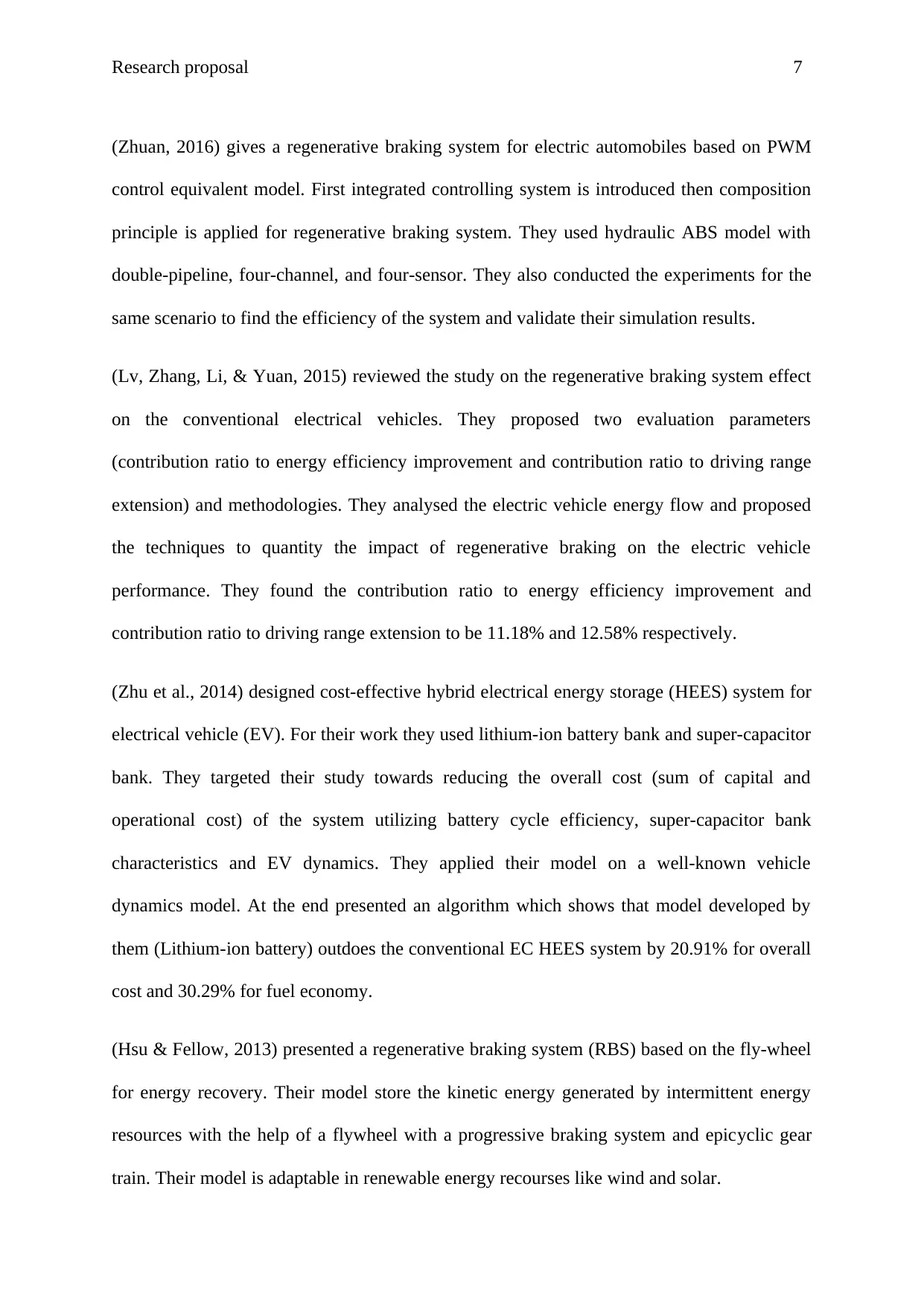
Research proposal 7
(Zhuan, 2016) gives a regenerative braking system for electric automobiles based on PWM
control equivalent model. First integrated controlling system is introduced then composition
principle is applied for regenerative braking system. They used hydraulic ABS model with
double-pipeline, four-channel, and four-sensor. They also conducted the experiments for the
same scenario to find the efficiency of the system and validate their simulation results.
(Lv, Zhang, Li, & Yuan, 2015) reviewed the study on the regenerative braking system effect
on the conventional electrical vehicles. They proposed two evaluation parameters
(contribution ratio to energy efficiency improvement and contribution ratio to driving range
extension) and methodologies. They analysed the electric vehicle energy flow and proposed
the techniques to quantity the impact of regenerative braking on the electric vehicle
performance. They found the contribution ratio to energy efficiency improvement and
contribution ratio to driving range extension to be 11.18% and 12.58% respectively.
(Zhu et al., 2014) designed cost-effective hybrid electrical energy storage (HEES) system for
electrical vehicle (EV). For their work they used lithium-ion battery bank and super-capacitor
bank. They targeted their study towards reducing the overall cost (sum of capital and
operational cost) of the system utilizing battery cycle efficiency, super-capacitor bank
characteristics and EV dynamics. They applied their model on a well-known vehicle
dynamics model. At the end presented an algorithm which shows that model developed by
them (Lithium-ion battery) outdoes the conventional EC HEES system by 20.91% for overall
cost and 30.29% for fuel economy.
(Hsu & Fellow, 2013) presented a regenerative braking system (RBS) based on the fly-wheel
for energy recovery. Their model store the kinetic energy generated by intermittent energy
resources with the help of a flywheel with a progressive braking system and epicyclic gear
train. Their model is adaptable in renewable energy recourses like wind and solar.
(Zhuan, 2016) gives a regenerative braking system for electric automobiles based on PWM
control equivalent model. First integrated controlling system is introduced then composition
principle is applied for regenerative braking system. They used hydraulic ABS model with
double-pipeline, four-channel, and four-sensor. They also conducted the experiments for the
same scenario to find the efficiency of the system and validate their simulation results.
(Lv, Zhang, Li, & Yuan, 2015) reviewed the study on the regenerative braking system effect
on the conventional electrical vehicles. They proposed two evaluation parameters
(contribution ratio to energy efficiency improvement and contribution ratio to driving range
extension) and methodologies. They analysed the electric vehicle energy flow and proposed
the techniques to quantity the impact of regenerative braking on the electric vehicle
performance. They found the contribution ratio to energy efficiency improvement and
contribution ratio to driving range extension to be 11.18% and 12.58% respectively.
(Zhu et al., 2014) designed cost-effective hybrid electrical energy storage (HEES) system for
electrical vehicle (EV). For their work they used lithium-ion battery bank and super-capacitor
bank. They targeted their study towards reducing the overall cost (sum of capital and
operational cost) of the system utilizing battery cycle efficiency, super-capacitor bank
characteristics and EV dynamics. They applied their model on a well-known vehicle
dynamics model. At the end presented an algorithm which shows that model developed by
them (Lithium-ion battery) outdoes the conventional EC HEES system by 20.91% for overall
cost and 30.29% for fuel economy.
(Hsu & Fellow, 2013) presented a regenerative braking system (RBS) based on the fly-wheel
for energy recovery. Their model store the kinetic energy generated by intermittent energy
resources with the help of a flywheel with a progressive braking system and epicyclic gear
train. Their model is adaptable in renewable energy recourses like wind and solar.
Paraphrase This Document
Need a fresh take? Get an instant paraphrase of this document with our AI Paraphraser
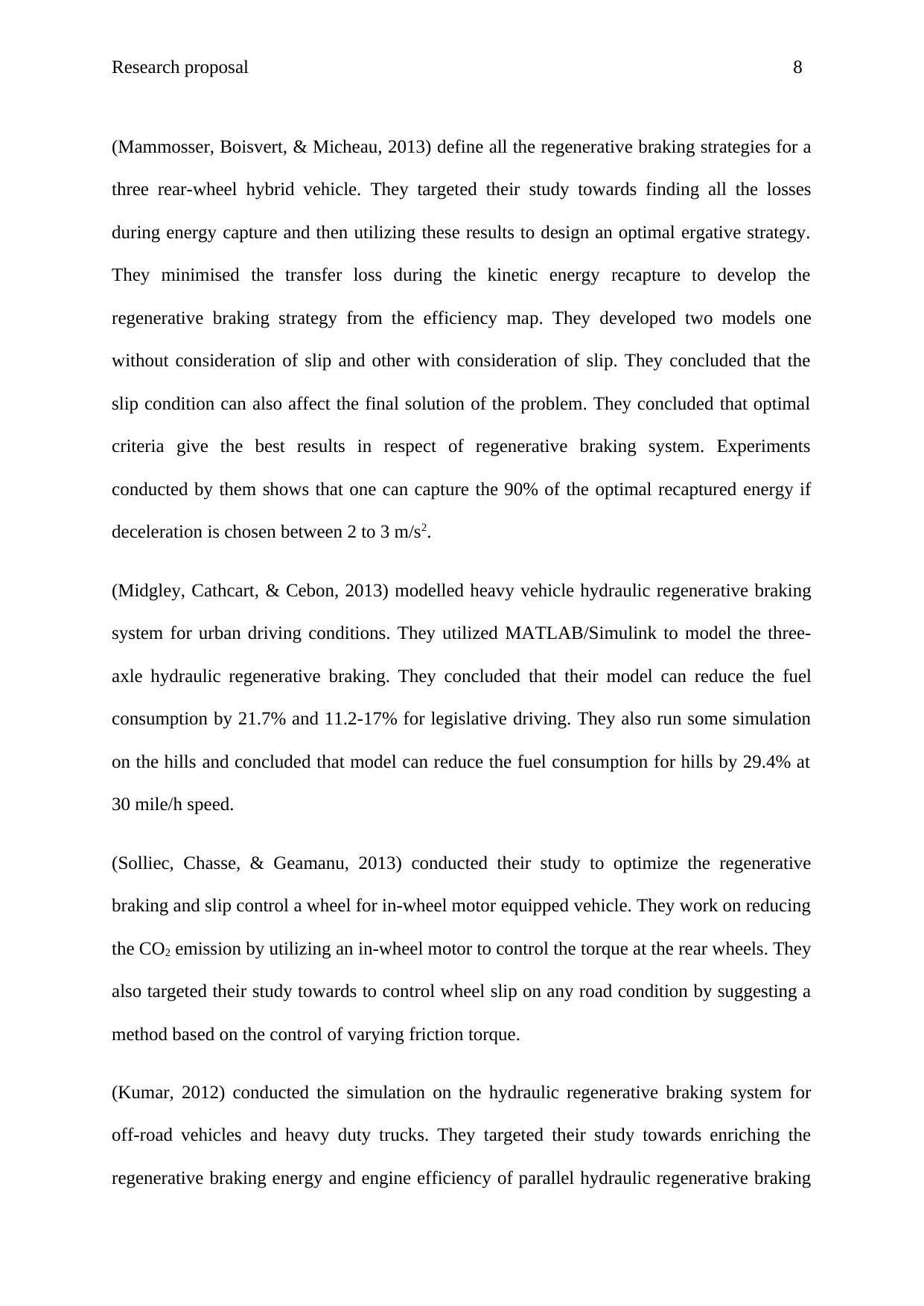
Research proposal 8
(Mammosser, Boisvert, & Micheau, 2013) define all the regenerative braking strategies for a
three rear-wheel hybrid vehicle. They targeted their study towards finding all the losses
during energy capture and then utilizing these results to design an optimal ergative strategy.
They minimised the transfer loss during the kinetic energy recapture to develop the
regenerative braking strategy from the efficiency map. They developed two models one
without consideration of slip and other with consideration of slip. They concluded that the
slip condition can also affect the final solution of the problem. They concluded that optimal
criteria give the best results in respect of regenerative braking system. Experiments
conducted by them shows that one can capture the 90% of the optimal recaptured energy if
deceleration is chosen between 2 to 3 m/s2.
(Midgley, Cathcart, & Cebon, 2013) modelled heavy vehicle hydraulic regenerative braking
system for urban driving conditions. They utilized MATLAB/Simulink to model the three-
axle hydraulic regenerative braking. They concluded that their model can reduce the fuel
consumption by 21.7% and 11.2-17% for legislative driving. They also run some simulation
on the hills and concluded that model can reduce the fuel consumption for hills by 29.4% at
30 mile/h speed.
(Solliec, Chasse, & Geamanu, 2013) conducted their study to optimize the regenerative
braking and slip control a wheel for in-wheel motor equipped vehicle. They work on reducing
the CO2 emission by utilizing an in-wheel motor to control the torque at the rear wheels. They
also targeted their study towards to control wheel slip on any road condition by suggesting a
method based on the control of varying friction torque.
(Kumar, 2012) conducted the simulation on the hydraulic regenerative braking system for
off-road vehicles and heavy duty trucks. They targeted their study towards enriching the
regenerative braking energy and engine efficiency of parallel hydraulic regenerative braking
(Mammosser, Boisvert, & Micheau, 2013) define all the regenerative braking strategies for a
three rear-wheel hybrid vehicle. They targeted their study towards finding all the losses
during energy capture and then utilizing these results to design an optimal ergative strategy.
They minimised the transfer loss during the kinetic energy recapture to develop the
regenerative braking strategy from the efficiency map. They developed two models one
without consideration of slip and other with consideration of slip. They concluded that the
slip condition can also affect the final solution of the problem. They concluded that optimal
criteria give the best results in respect of regenerative braking system. Experiments
conducted by them shows that one can capture the 90% of the optimal recaptured energy if
deceleration is chosen between 2 to 3 m/s2.
(Midgley, Cathcart, & Cebon, 2013) modelled heavy vehicle hydraulic regenerative braking
system for urban driving conditions. They utilized MATLAB/Simulink to model the three-
axle hydraulic regenerative braking. They concluded that their model can reduce the fuel
consumption by 21.7% and 11.2-17% for legislative driving. They also run some simulation
on the hills and concluded that model can reduce the fuel consumption for hills by 29.4% at
30 mile/h speed.
(Solliec, Chasse, & Geamanu, 2013) conducted their study to optimize the regenerative
braking and slip control a wheel for in-wheel motor equipped vehicle. They work on reducing
the CO2 emission by utilizing an in-wheel motor to control the torque at the rear wheels. They
also targeted their study towards to control wheel slip on any road condition by suggesting a
method based on the control of varying friction torque.
(Kumar, 2012) conducted the simulation on the hydraulic regenerative braking system for
off-road vehicles and heavy duty trucks. They targeted their study towards enriching the
regenerative braking energy and engine efficiency of parallel hydraulic regenerative braking
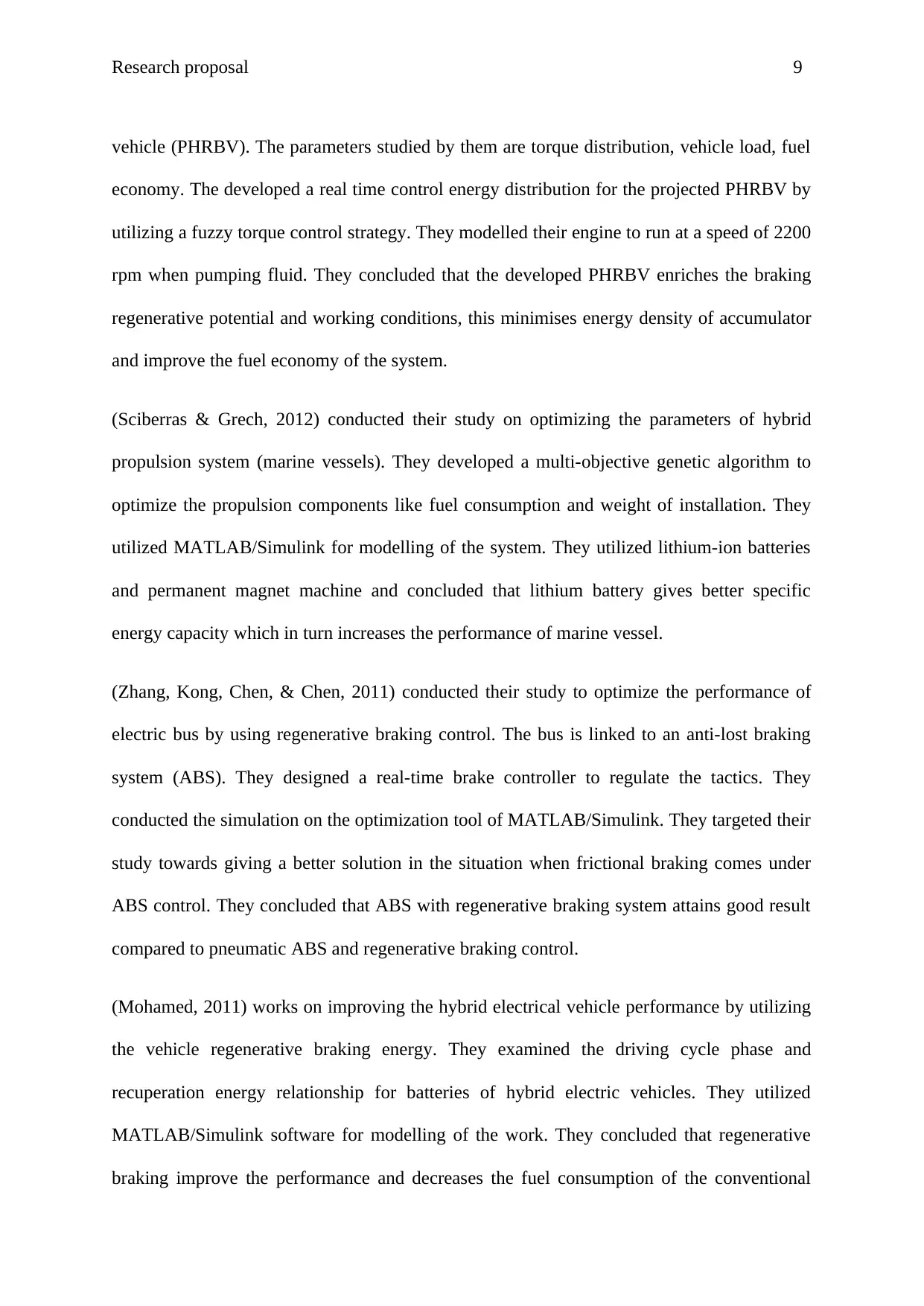
Research proposal 9
vehicle (PHRBV). The parameters studied by them are torque distribution, vehicle load, fuel
economy. The developed a real time control energy distribution for the projected PHRBV by
utilizing a fuzzy torque control strategy. They modelled their engine to run at a speed of 2200
rpm when pumping fluid. They concluded that the developed PHRBV enriches the braking
regenerative potential and working conditions, this minimises energy density of accumulator
and improve the fuel economy of the system.
(Sciberras & Grech, 2012) conducted their study on optimizing the parameters of hybrid
propulsion system (marine vessels). They developed a multi-objective genetic algorithm to
optimize the propulsion components like fuel consumption and weight of installation. They
utilized MATLAB/Simulink for modelling of the system. They utilized lithium-ion batteries
and permanent magnet machine and concluded that lithium battery gives better specific
energy capacity which in turn increases the performance of marine vessel.
(Zhang, Kong, Chen, & Chen, 2011) conducted their study to optimize the performance of
electric bus by using regenerative braking control. The bus is linked to an anti-lost braking
system (ABS). They designed a real-time brake controller to regulate the tactics. They
conducted the simulation on the optimization tool of MATLAB/Simulink. They targeted their
study towards giving a better solution in the situation when frictional braking comes under
ABS control. They concluded that ABS with regenerative braking system attains good result
compared to pneumatic ABS and regenerative braking control.
(Mohamed, 2011) works on improving the hybrid electrical vehicle performance by utilizing
the vehicle regenerative braking energy. They examined the driving cycle phase and
recuperation energy relationship for batteries of hybrid electric vehicles. They utilized
MATLAB/Simulink software for modelling of the work. They concluded that regenerative
braking improve the performance and decreases the fuel consumption of the conventional
vehicle (PHRBV). The parameters studied by them are torque distribution, vehicle load, fuel
economy. The developed a real time control energy distribution for the projected PHRBV by
utilizing a fuzzy torque control strategy. They modelled their engine to run at a speed of 2200
rpm when pumping fluid. They concluded that the developed PHRBV enriches the braking
regenerative potential and working conditions, this minimises energy density of accumulator
and improve the fuel economy of the system.
(Sciberras & Grech, 2012) conducted their study on optimizing the parameters of hybrid
propulsion system (marine vessels). They developed a multi-objective genetic algorithm to
optimize the propulsion components like fuel consumption and weight of installation. They
utilized MATLAB/Simulink for modelling of the system. They utilized lithium-ion batteries
and permanent magnet machine and concluded that lithium battery gives better specific
energy capacity which in turn increases the performance of marine vessel.
(Zhang, Kong, Chen, & Chen, 2011) conducted their study to optimize the performance of
electric bus by using regenerative braking control. The bus is linked to an anti-lost braking
system (ABS). They designed a real-time brake controller to regulate the tactics. They
conducted the simulation on the optimization tool of MATLAB/Simulink. They targeted their
study towards giving a better solution in the situation when frictional braking comes under
ABS control. They concluded that ABS with regenerative braking system attains good result
compared to pneumatic ABS and regenerative braking control.
(Mohamed, 2011) works on improving the hybrid electrical vehicle performance by utilizing
the vehicle regenerative braking energy. They examined the driving cycle phase and
recuperation energy relationship for batteries of hybrid electric vehicles. They utilized
MATLAB/Simulink software for modelling of the work. They concluded that regenerative
braking improve the performance and decreases the fuel consumption of the conventional
⊘ This is a preview!⊘
Do you want full access?
Subscribe today to unlock all pages.

Trusted by 1+ million students worldwide
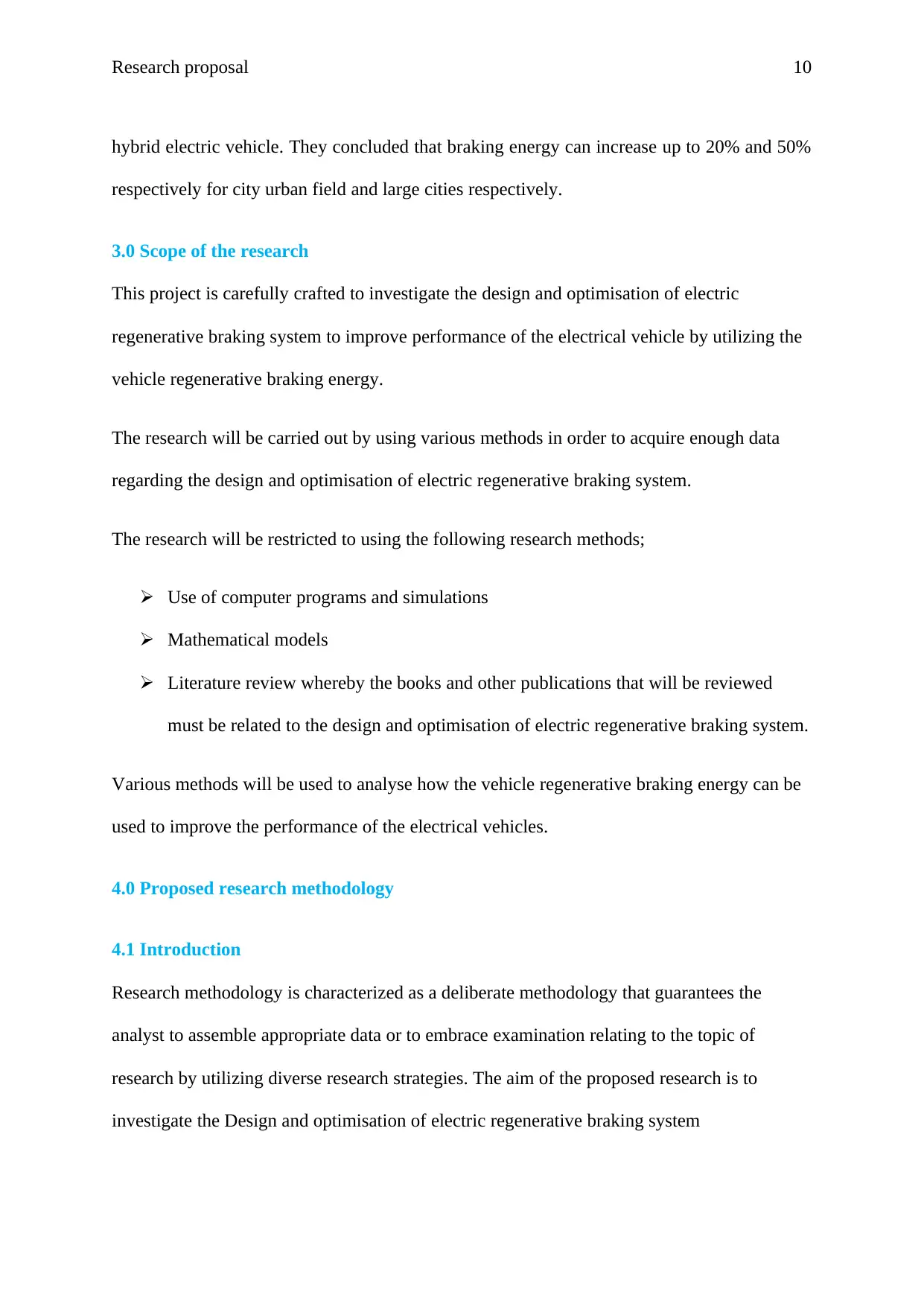
Research proposal 10
hybrid electric vehicle. They concluded that braking energy can increase up to 20% and 50%
respectively for city urban field and large cities respectively.
3.0 Scope of the research
This project is carefully crafted to investigate the design and optimisation of electric
regenerative braking system to improve performance of the electrical vehicle by utilizing the
vehicle regenerative braking energy.
The research will be carried out by using various methods in order to acquire enough data
regarding the design and optimisation of electric regenerative braking system.
The research will be restricted to using the following research methods;
Use of computer programs and simulations
Mathematical models
Literature review whereby the books and other publications that will be reviewed
must be related to the design and optimisation of electric regenerative braking system.
Various methods will be used to analyse how the vehicle regenerative braking energy can be
used to improve the performance of the electrical vehicles.
4.0 Proposed research methodology
4.1 Introduction
Research methodology is characterized as a deliberate methodology that guarantees the
analyst to assemble appropriate data or to embrace examination relating to the topic of
research by utilizing diverse research strategies. The aim of the proposed research is to
investigate the Design and optimisation of electric regenerative braking system
hybrid electric vehicle. They concluded that braking energy can increase up to 20% and 50%
respectively for city urban field and large cities respectively.
3.0 Scope of the research
This project is carefully crafted to investigate the design and optimisation of electric
regenerative braking system to improve performance of the electrical vehicle by utilizing the
vehicle regenerative braking energy.
The research will be carried out by using various methods in order to acquire enough data
regarding the design and optimisation of electric regenerative braking system.
The research will be restricted to using the following research methods;
Use of computer programs and simulations
Mathematical models
Literature review whereby the books and other publications that will be reviewed
must be related to the design and optimisation of electric regenerative braking system.
Various methods will be used to analyse how the vehicle regenerative braking energy can be
used to improve the performance of the electrical vehicles.
4.0 Proposed research methodology
4.1 Introduction
Research methodology is characterized as a deliberate methodology that guarantees the
analyst to assemble appropriate data or to embrace examination relating to the topic of
research by utilizing diverse research strategies. The aim of the proposed research is to
investigate the Design and optimisation of electric regenerative braking system
Paraphrase This Document
Need a fresh take? Get an instant paraphrase of this document with our AI Paraphraser
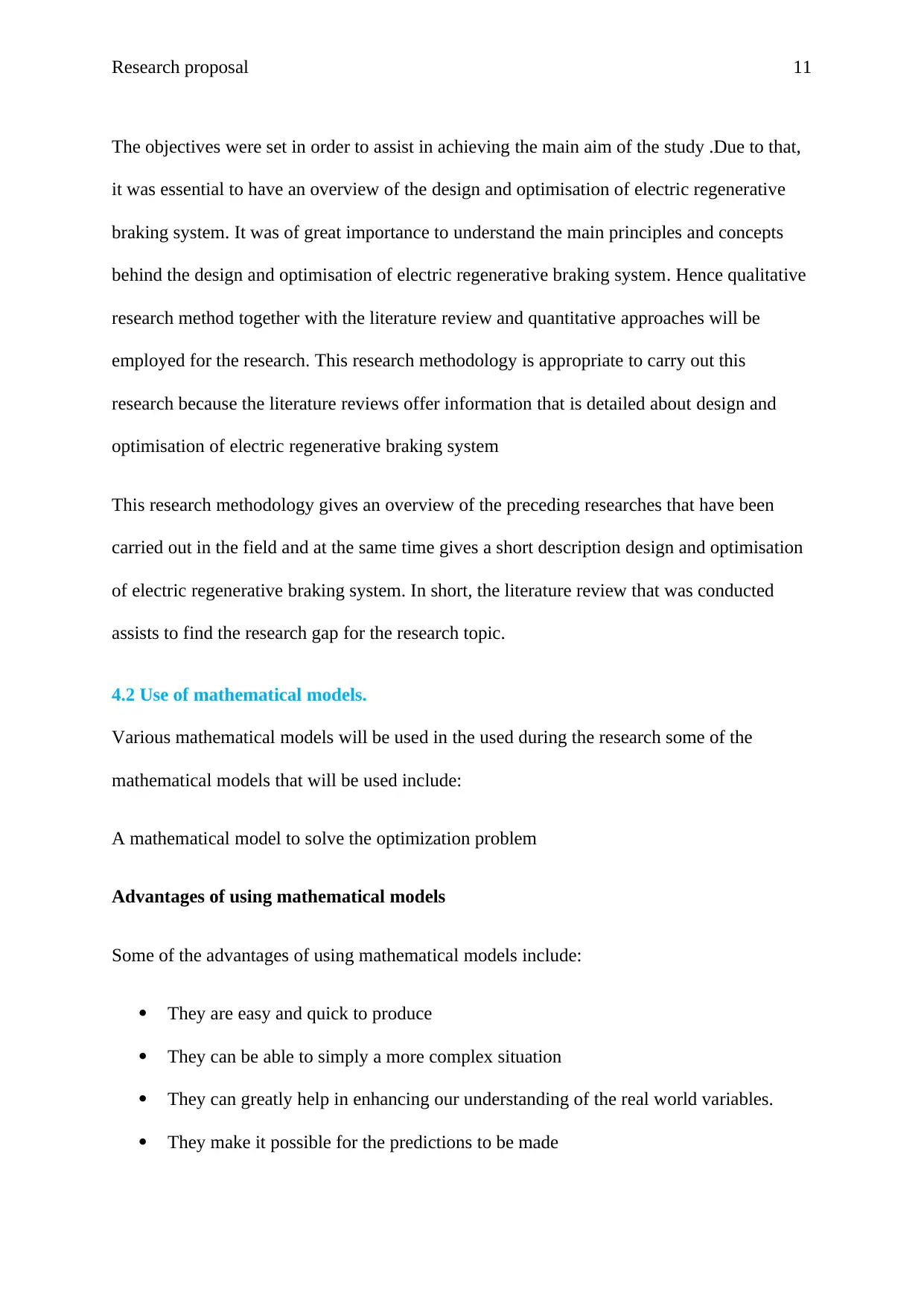
Research proposal 11
The objectives were set in order to assist in achieving the main aim of the study .Due to that,
it was essential to have an overview of the design and optimisation of electric regenerative
braking system. It was of great importance to understand the main principles and concepts
behind the design and optimisation of electric regenerative braking system. Hence qualitative
research method together with the literature review and quantitative approaches will be
employed for the research. This research methodology is appropriate to carry out this
research because the literature reviews offer information that is detailed about design and
optimisation of electric regenerative braking system
This research methodology gives an overview of the preceding researches that have been
carried out in the field and at the same time gives a short description design and optimisation
of electric regenerative braking system. In short, the literature review that was conducted
assists to find the research gap for the research topic.
4.2 Use of mathematical models.
Various mathematical models will be used in the used during the research some of the
mathematical models that will be used include:
A mathematical model to solve the optimization problem
Advantages of using mathematical models
Some of the advantages of using mathematical models include:
They are easy and quick to produce
They can be able to simply a more complex situation
They can greatly help in enhancing our understanding of the real world variables.
They make it possible for the predictions to be made
The objectives were set in order to assist in achieving the main aim of the study .Due to that,
it was essential to have an overview of the design and optimisation of electric regenerative
braking system. It was of great importance to understand the main principles and concepts
behind the design and optimisation of electric regenerative braking system. Hence qualitative
research method together with the literature review and quantitative approaches will be
employed for the research. This research methodology is appropriate to carry out this
research because the literature reviews offer information that is detailed about design and
optimisation of electric regenerative braking system
This research methodology gives an overview of the preceding researches that have been
carried out in the field and at the same time gives a short description design and optimisation
of electric regenerative braking system. In short, the literature review that was conducted
assists to find the research gap for the research topic.
4.2 Use of mathematical models.
Various mathematical models will be used in the used during the research some of the
mathematical models that will be used include:
A mathematical model to solve the optimization problem
Advantages of using mathematical models
Some of the advantages of using mathematical models include:
They are easy and quick to produce
They can be able to simply a more complex situation
They can greatly help in enhancing our understanding of the real world variables.
They make it possible for the predictions to be made
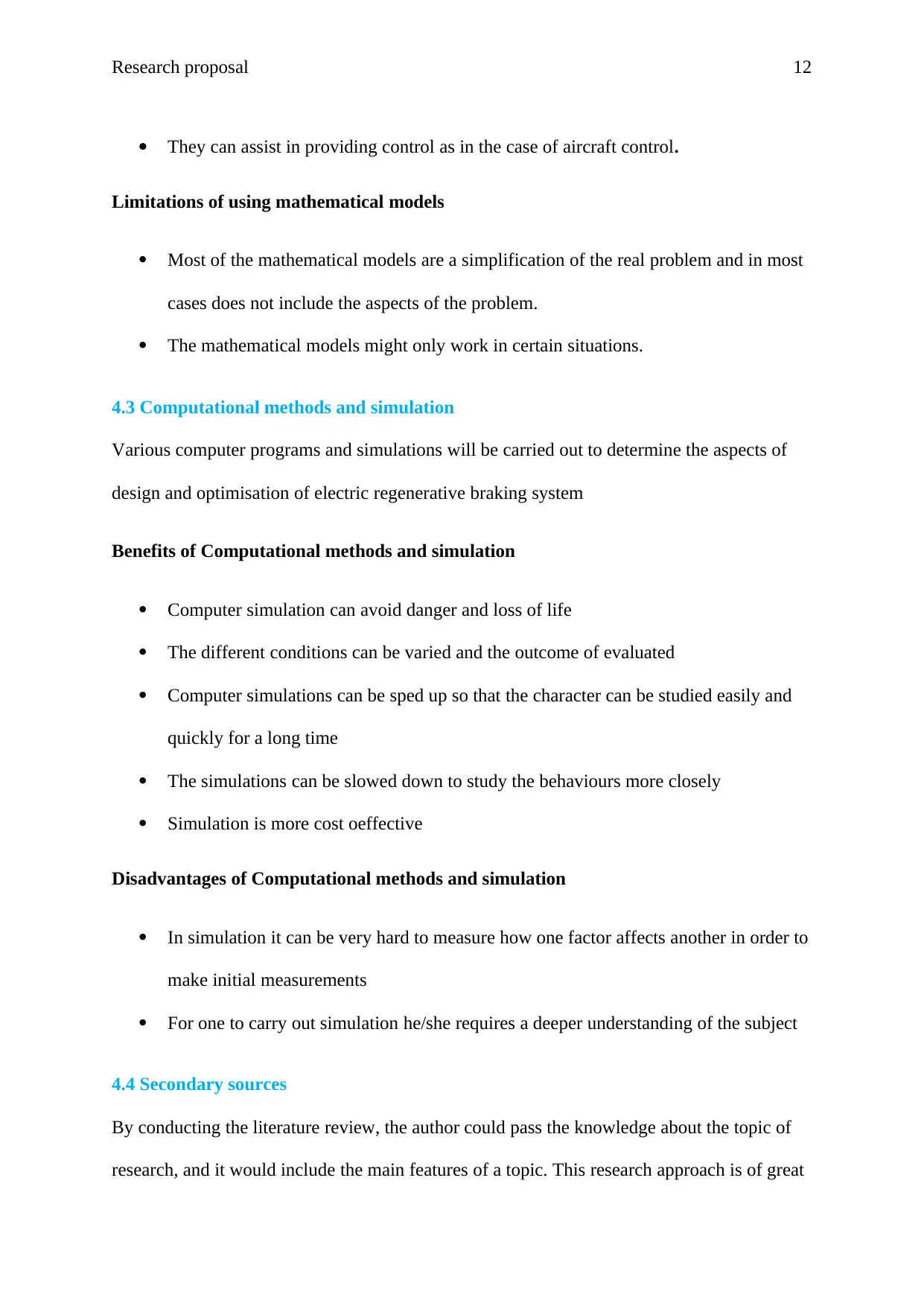
Research proposal 12
They can assist in providing control as in the case of aircraft control.
Limitations of using mathematical models
Most of the mathematical models are a simplification of the real problem and in most
cases does not include the aspects of the problem.
The mathematical models might only work in certain situations.
4.3 Computational methods and simulation
Various computer programs and simulations will be carried out to determine the aspects of
design and optimisation of electric regenerative braking system
Benefits of Computational methods and simulation
Computer simulation can avoid danger and loss of life
The different conditions can be varied and the outcome of evaluated
Computer simulations can be sped up so that the character can be studied easily and
quickly for a long time
The simulations can be slowed down to study the behaviours more closely
Simulation is more cost oeffective
Disadvantages of Computational methods and simulation
In simulation it can be very hard to measure how one factor affects another in order to
make initial measurements
For one to carry out simulation he/she requires a deeper understanding of the subject
4.4 Secondary sources
By conducting the literature review, the author could pass the knowledge about the topic of
research, and it would include the main features of a topic. This research approach is of great
They can assist in providing control as in the case of aircraft control.
Limitations of using mathematical models
Most of the mathematical models are a simplification of the real problem and in most
cases does not include the aspects of the problem.
The mathematical models might only work in certain situations.
4.3 Computational methods and simulation
Various computer programs and simulations will be carried out to determine the aspects of
design and optimisation of electric regenerative braking system
Benefits of Computational methods and simulation
Computer simulation can avoid danger and loss of life
The different conditions can be varied and the outcome of evaluated
Computer simulations can be sped up so that the character can be studied easily and
quickly for a long time
The simulations can be slowed down to study the behaviours more closely
Simulation is more cost oeffective
Disadvantages of Computational methods and simulation
In simulation it can be very hard to measure how one factor affects another in order to
make initial measurements
For one to carry out simulation he/she requires a deeper understanding of the subject
4.4 Secondary sources
By conducting the literature review, the author could pass the knowledge about the topic of
research, and it would include the main features of a topic. This research approach is of great
⊘ This is a preview!⊘
Do you want full access?
Subscribe today to unlock all pages.

Trusted by 1+ million students worldwide
1 out of 18
Related Documents
Your All-in-One AI-Powered Toolkit for Academic Success.
+13062052269
info@desklib.com
Available 24*7 on WhatsApp / Email
![[object Object]](/_next/static/media/star-bottom.7253800d.svg)
Unlock your academic potential
Copyright © 2020–2025 A2Z Services. All Rights Reserved. Developed and managed by ZUCOL.





